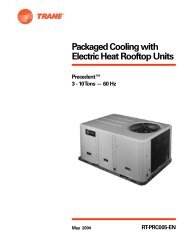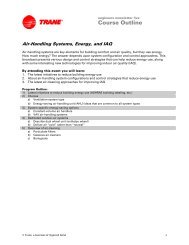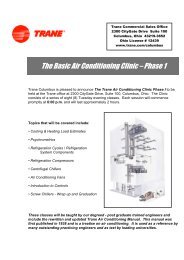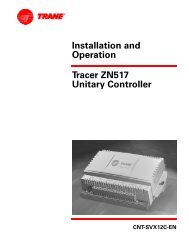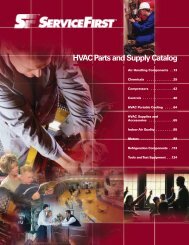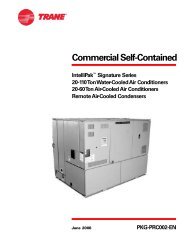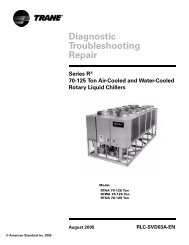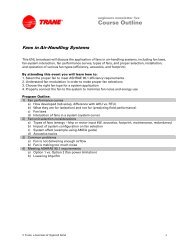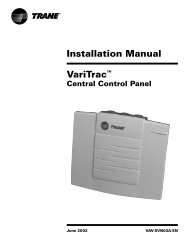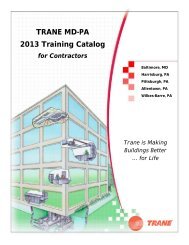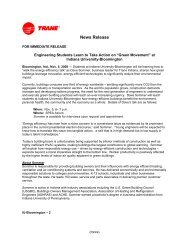Air-Cooled Series R⢠Rotary Liquid Chiller - Trane
Air-Cooled Series R⢠Rotary Liquid Chiller - Trane
Air-Cooled Series R⢠Rotary Liquid Chiller - Trane
Create successful ePaper yourself
Turn your PDF publications into a flip-book with our unique Google optimized e-Paper software.
<strong>Series</strong> <strong>Chiller</strong> Arrangements<br />
Another energy-saving strategy is to<br />
design the system around chillers<br />
arranged in series. The actual savings<br />
possible with such strategies depends<br />
on the application dynamics and should<br />
be researched by consulting your <strong>Trane</strong><br />
Systems Solutions Representative and<br />
applying the <strong>Trane</strong> System Analyzer<br />
program. It is possible to operate a pair<br />
of chillers more efficiently in a series<br />
chiller arrangement than in a parallel<br />
arrangement. It is also possible to<br />
achieve higher entering-to-leaving chiller<br />
differentials, which may, in turn, provide<br />
the opportunity for lower chilled water<br />
design temperature, lower design flow,<br />
and resulting installation and operational<br />
cost savings. The Trance screw<br />
compressor also has excellent<br />
capabilities for “lift,” which affords an<br />
opportunity for savings on the<br />
evaporator water loop.<br />
Figure A3. Typical series chiller arrangement<br />
14<br />
Application<br />
Considerations<br />
<strong>Series</strong> chiller arrangements can be<br />
controlled in several ways. Figure A3<br />
shows a strategy where each chiller is<br />
trying to achieve the system design set<br />
point. If the cooling load is less than 50<br />
percent of the systems capabilities,<br />
either chiller can fulfill the demand. As<br />
system loads increase, the <strong>Chiller</strong> 2<br />
becomes preferentially loaded as it<br />
attempts to meet the leaving chilled<br />
water setpoint. <strong>Chiller</strong> 1 will finish<br />
cooling the leaving water from <strong>Chiller</strong> 2<br />
down to the system design setpoint.<br />
Staggering the chiller set points is<br />
another control technique that works<br />
well for preferentially loading <strong>Chiller</strong> 1. If<br />
the cooling load is less than 50 percent<br />
of the system capacity, <strong>Chiller</strong> 1 would<br />
be able to satisfy the entire call for<br />
cooling. As system loads increase,<br />
<strong>Chiller</strong> 2 is started to meet any portion of<br />
the load that <strong>Chiller</strong> 1 can not meet.<br />
Typical Water Piping<br />
All building water piping must be<br />
flushed prior to making the final<br />
connections to the chiller. To reduce heat<br />
loss and prevent condensation,<br />
insulation should be installed. Expansion<br />
tanks are also usually required so that<br />
chilled water volume changes can be<br />
accommodated.<br />
RLC-PRC006-EN




